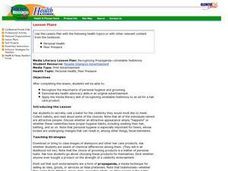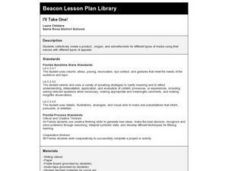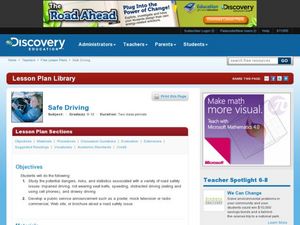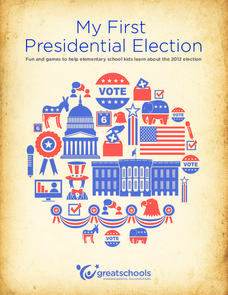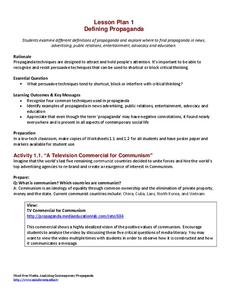Curated OER
Shopping Bag Challenge
Students design a shopping bag that will allow the consumer to immediately identify the store and understand the product that is being sold. They create an advertisement for a new shopping bag. Students choose their type of business to...
Curated OER
Stretching It
Students recognize the use of exaggeration and understand how it may enhance the story, painting, conversation or event. Students transfer their understanding of exaggeration as it is used in many places, ie., daily life, paintings,...
Curated OER
Recognizing Propaganda - Unreliable Testimony
Young scholars investigate how product endorsements can be a form of propaganda. They analyze various shampoo ads, discuss celebrity endorsements and unreliable testimony, and create a written non-propaganda ad for or against a celebrity...
Curated OER
Inventive Thinking - Future Inventions
Students create marketing campaigns. In this technology skills lesson, students keep a log as they build prototypes of their inventions. Students then script and record video commercials to sell the prototypes.
Curated OER
Media Views
Students create a collage of images depicting trends in the media. In this media lesson, students watch excerpts from several films, television shows, and commercials. Students compare and contrast media views...
Curated OER
Hidden Messages: The Growth of Product Placement
Pupils identify product placements they see in TV programs and movies. They build awareness of the pervasiveness of advertising in their culture. They develop critical skills necessary to think independently in a media saturated consumer...
Curated OER
Popular Culture
Learners analyze the period of Belle Epoque and the methods of art that signified popular culture. In this art analysis lesson, students consider the ways popular culture influenced art by analyzing the images and completing image based...
Curated OER
Diseases on Ships
Students create a presentation on one of seven diseases common to sea going ships. In this diseases on ships lesson, students research diseases commonly found on ships of the late 16th and early 18th centuries. Students...
Curated OER
I'll Take One!
Fourth graders collectively create a product, slogan, and advertisements for different types of media. They define different types of appeals such as bandwagon, emotional, glittering generalities, snob appeal, plain-folks appeal,...
Curated OER
Everyone Knows It's Windy
Students create an anemometer, an instrument that measures wind speed.
Curated OER
Pop Art-Reflections of the Mass Media
Students select a common object or a face, and draw or paint it on a flat surface making it larger than real life. They choose a common object or simple scene and repeat it horizontally or vertically as defined rows. They create a flat,...
Curated OER
Safe Driving
Students explore the implications of teen driving. In this personal health lesson, students research and discuss impaired driving, seat belt usage, speeding, and distracted driving. Students then create public awareness marketing...
Curated OER
Dogfighting Unit Lesson Five--The Media and Propaganda
Students consider the implications of dogfighting. In this character education lesson, students examine propaganda in advertising and then create their own anti-dogfighting advertisements.
Curated OER
Survivor Vs. Canterbury Tales
Eleventh graders participate in activities that compare and contrast The Canterbury Tales with the television show, Survivor. They write a compare and contrast essay, and create a festival table and PowerPoint presentation.
Curated OER
Time Machine: Drive for the American Dream
Learners view a documentary on automobiles. Americans have always been in love with automobiles. They are a definition of character, and a representation of social status. After viewing, students discuss what they saw and create an...
Curated OER
Designing A Dream Store
Students plan, create, and advertise their own original store. They identify various types of stores, develop a business plan for a unique store, plan an advertising campaign, and present their campaign to the class.
Curated OER
Sterotypes
High schoolers participate in a variety of activities in order to explore the concept of a stereotype. The concept of diversity is also mentioned to contrast a stereotype. The goal of the lesson plan is to create an understanding of how...
Curated OER
The Colonies: An Adertisement
Learners explore the early colonies of American settlements. After researching important characteristics such as land, politics, economics, and educational opportunities, students create their own advertisement for one of the colonies.
Curated OER
Behind the Ad: The Process of Producing a Political Commerical
Students examine how advertisements are produced for political campaigns. In groups, they view various examples of different advertisements and create their own ad by completing the steps listed in the lesson plan. They share their ad...
Curated OER
The Persuasive Message
Eighth graders engage in a study of persuasive writing. They conduct research looking at a variety of media resources looking for persuasive techniques that are used like advertising. The language of the advertising is examined for how...
Great Schools
My First Presidential Election
Register, establish a platform, make campaign speeches, and design campaign advertisements with a study of presidential elections. Young citizens engage in various activities that mimic the election process.
Media Education Lab
Defining Propaganda
21st century learners live in a media world. Help them develop the skills they need to be able to analyze the barrage of propaganda they face daily, with a resource that introduces them to the type of persuasive appeals found in...
Curated OER
Preserving Democracy
Young scholars read excerpts of the Declaration of Independence and United States Constitution. Using the documents, they identify the ideas of how the government should be run. In groups, they develop a skit that encourages people to be...
Virginia Department of Education
Media Literacy and Persuasive Writing
Investigate ways to persuade by introducing learners to the three rhetorical appeals (Pathos, Logos, Ethos). Pupils receive a worksheet for their definition development of the terms and coinciding vocabulary words. The activity continues...


